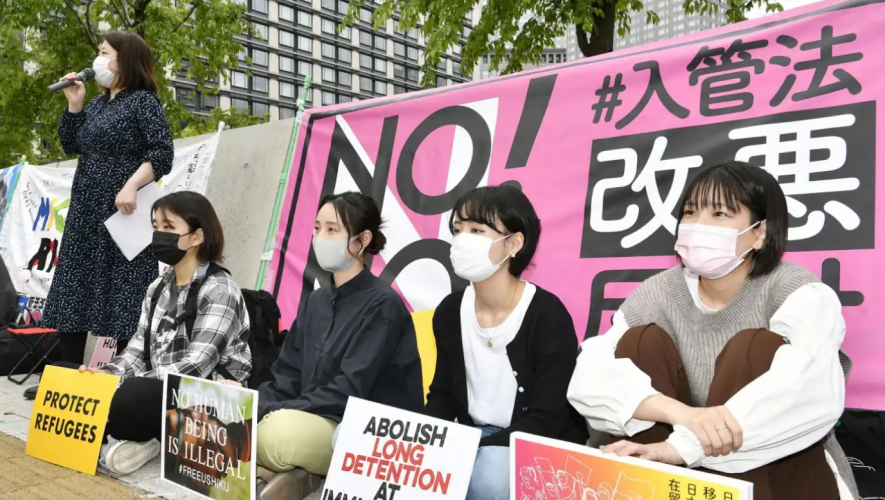This article discusses violence, suicide, and self-harm.
On March 6, 2021, Wishma Sandamali, a Sri Lankan national who entered Japan on a student visa, died in custody at an Aichi Prefecture immigration detention facility. In August 2020, authorities arrested and detained her for overstaying her visa after seeking help from police officials regarding a domestic violence dispute. Two days before her death, the Immigration Services Agency of Japan rejected Sandamali’s application for provisional release despite a psychiatrist’s recommendation.
In May 2021, news of Sandamali’s death spread through social media and international news outlets. This global attention highlighted the massive failures of Japan’s immigration system. Asylum seekers, low-skill technical interns, and those who overstay visas face horrendous conditions like brutally long detention sentences in poor facilities, forced labor, inaccessible healthcare, and nearly guaranteed rejection for asylum status.
Tragically, this was not the first time such an incident occurred in facilities operated by the Ministry of Justice (MOJ). In June 2019, a Nigerian man participating in a hunger strike died in Nagasaki Prefecture. In 2017, a Vietnamese man committed suicide while in solitary confinement at the Higashi Nihon Immigration Center. In 2016, a Sri Lankan man died of a heart attack due to poor medical care at a Tokyo detention center, a facility where fourteen inmates attempted suicide or self-harm the previous year. The list goes on; since 1997, there have been at least twenty-four reported deaths of foreign detainees under the watch of the MOJ. However, the Government of Japan (GOJ) has taken little action to remedy the practices that cause these tragedies.
Japan’s immigration system serves as a hindrance, not a vehicle, in vulnerable peoples’s journeys towards opportunity and safety. The deaths of detainees like Wishma Sandamali are symptoms of the broader failures of the GOJ to deliver safe immigration policies that are mutually beneficial to both foreigners and the Japanese public.
Economic Migrants
Many of Japan’s most vulnerable migrants immigrate for economic opportunity. In 1993, the GOJ established the Technical Intern Training Program (TITP), a scheme meant to support international cooperation by allowing foreign “intern trainees” to gain technical experience working for Japanese firms before returning to their home countries. Such experience covers a variety of technical industries, ranging from fisheries and agriculture to construction and food manufacturing. The GOJ expanded the program in 2016; over 400,000 trainee interns resided in Japan by the end of 2020, more than a 200 percent increase from 2011.
TITP seems like an effective program for sharing technical knowledge with lesser-developed countries and strengthening international cooperation. However, many allege that the former Abe Shinzo administration supported the program’s expansion to import human capital, despite TITP’s clear restrictions on such practices. It seems as though the GOJ diverts from its traditional stance on immigration when it is in its self-interest. Indeed, domestic firms have systematically abused TITP among ongoing labor shortages. A study by the Ministry of Internal Affairs and Communications found that at roughly 19 percent of surveyed enterprises, foreign trainees constituted half of the labor force. In 4 percent, the labor force was composed entirely of foreign trainees, meaning firms supplement their workforce with trainees’s cheaper labor.
Beyond the structural violations of TITP’s spirit, trainees report widespread labor laws and human rights violations by their hosting enterprises. The program often assigns workers to jobs that do not even teach technical skills. In 2018 alone, the Japan Organization for Technical Intern Training reported 4,707 instances of host enterprises violating the human rights of their trainees. Some employers confiscate trainees’s passports or require expensive deposits to ensure they complete their labor, a practice that creates impossibly high debts for participants. Unchecked actions like these heighten the vulnerability of trainees and open the door to sexual and labor trafficking, particularly among women, through their lack of socioeconomic and physical mobility.
Despite these widespread reports of exploitation, the GOJ has taken no major policy initiatives to reform the conditions facing trainees. This inaction continues the systemic exploitation of foreign trainees while heightening their vulnerability, all under the guise of “international cooperation.”
Struggles for Asylum Status
While low-income migrants and technical interns encounter hardships, asylum seekers have by far the most challenging immigration process. The dramatic rise in the global refugee population over the last decade caused a sharp increase in asylum claims worldwide. Japan is no exception, with over 19,600 applications in 2017, up from around 12,000 in 2010. However, the MOJ’s acceptance rate of these applications decreased by nearly 44 percent between 2017 and 2019. In fact, it remains by far the lowest acceptance rate among developed democracies at just 0.4 percent in 2019, meaning Japan approved a mere forty-four cases. By comparison, Germany, with a smaller economy and population, accepted over 45,000 cases that same year.
This abysmal rate brings with it severe consequences for asylum seekers. The system forces rejected applicants to endure extensive detention with little chance for judicial review. Following the rejection, applicants can petition courts to review their case, though the acceptance rate for this process is also absurdly low. Furthermore, all applicants without active asylum applications are subject to deportation. The MOJ does not limit the number of application attempts, leading to cyclical re-application among asylum seekers, trapping them in a legal gray zone.
Deportation forces asylum seekers to depart Japan’s safety and return to their home countries, the very source of their danger. This policy violates the non-refoulement obligations set under the 1951 Convention Relating to the Status of Refugees, of which Japan is a signing member. However, no institution has successfully stopped the MOJ’s practices through legal action.
This framework becomes even more problematic within the context of Japan’s provisional stay policy, which requires asylum seekers to separately apply for permission to remain in Japan beyond their visa expiration date while the MOJ considers their asylum application. Given the roughly two-year-long asylum application process, asylum seekers who are denied provisional stay status and enter Japan on a standard ninety-day tourist visa by default become overstayers. Thus, they are at risk of deportation before the GOJ even assesses their vulnerability and risk.
Japan has made notable exceptions to its treatment of asylum seekers when international criticism is at stake. At the Olympic Games this past summer, Belarus recalled one athlete after she publicly criticized the authoritarian regime of Alexander Lukashenko. Under the global spotlight, Japan deviated from its usual practices by housing the athlete at a Haneda Airport hotel until she obtained a humanitarian visa from the Polish Embassy. It is clear that unless the GOJ can score political points, asylum seekers are far more likely to be sent back to harm’s way than given safety.
Medical Access
The GOJ employs mechanisms to prevent asylum seekers and migrants from overstaying their visas or asylum application windows that drastically increase vulnerability by cutting off access to medical treatment, in or outside detention centers.
Those without proper visa status cannot enroll in the country’s National Health Insurance. Recently, many hospitals have also begun to enforce ID and health insurance card checks for foreigners, further raising the barriers to treatment access. Legal employment and access to employer-sponsored private health insurance are impossible for most overstayers. The high cost of treatment without insurance and the lack of a comprehensive social safety net mean adequate healthcare remains prohibitively expensive for most visa overstayers. This lack of financial support for healthcare results in financial burdens for hospitals through unpaid bills. To prioritize profitability, many hospitals deny urgent care to undocumented patients.
For the over 22,000 foreigners in detention at immigration facilities, conditions are harsh, and access to medical care is limited. Health professionals, in some cases, visit just twice a week and there are no on-duty physicians at any MOJ-run facilities over weekends. These severe conditions and extended sentences led to many instances of death or suicide among detainees. They actively endanger the lives of those in custody, particularly since the onset of the COVID-19 pandemic. In February 2021, fifty-eight detainees tested positive for COVID-19 at the Tokyo Regional Immigration Bureau, a facility that lacks outdoor spaces and proper social distancing capabilities. Individuals in detention are therefore at a heightened risk for infection compared to the general public.
The MOJ’s use of extended sentences at detention facilities to deter visa overstays compounds the danger detainees face. For example, at the Higashi Nihon Immigration Center, 88 percent of detainees were in detention for at least one year as of June 2019. Through extended detention, detainees cannot access proper healthcare for the duration of their stays, in and of itself a cruel punishment.
The danger associated with the lack of proper healthcare in these facilities is made significantly worse by the staff’s poor treatment of detainees. Many report physical abuse by their guards. In August 2021, a detainee in Ibaraki Prefecture suffered a neck injury after a guard strangled him and denied him access to healthcare. In February of this year, a video surfaced of a 2018 incident in which guards at a Tokyo detention center threw a Brazilian man on the ground and twisted his arm behind his back. As the man screamed in pain, guards told him to “shut up” and “be quiet.” Such harsh conditions have resulted in immense suffering for detainees, so much so that hunger strikes are by no means uncommon. Detainees thus do not just face a lack of healthcare, but harsh conditions that jeopardize their health in the first place.
Despite Japan’s developed healthcare capabilities, the current immigration system excludes those without legal status from accessing proper medical treatment. Sentences in Japan’s detention centers are safety risks for detainees, lead to preventable deaths, and exponentially heighten the vulnerability of foreign migrants.
Policy Reform
Japan’s immigration system favors restricted migration and jeopardizes the wellbeing and safety of the country’s most at-risk migrants. The system is an endangerment to vulnerable individuals who enter it; it is failing, and an overhaul of the policies that sustain it is long overdue.
Specifically, the GOJ must revise its policies regarding applications for asylum status, technical training programs, and immigration detention procedures. Further, it must immediately cease issuing deportation orders for asylum seekers before re-evaluating the many other systems that currently endanger low-income foreigners’s lives.
Beyond a glaring moral imperative to assist asylum seekers and provide safe working opportunities to migrants, it is also in Japan’s long-term economic interest to reform and expand its immigration system. The country faces an unprecedented population crisis; experts predict that the domestic labor force will shrink by 40 percent, or 30 million workers, by 2065.
The GOJ took steps trying to address this, such as the 2018 House of Councilors bill that expanded blue-collar employment opportunities to around 345,000 foreigners. However, even this bill, one of the most liberal immigration policy changes in decades, comes far short of satisfying Japan’s present and future labor demands. Should the GOJ implement sustainable and mutually beneficial immigration policies, the country could satisfy its labor shortages without subjecting migrants to exploitative practices.
However, public and institutional hesitancy remains a significant barrier to achieving immigration reform. The issue has long been a third rail in Japanese politics as the subject remains taboo among the public despite its potential economic advantages. This structural hesitancy has allowed the GOJ to continue operating its restrictive policies without significant and lasting internal pressure. In fact, until the international media attention following Wishma Sandamali’s death, Japanese politicians advocated for even further restrictions on immigration. In 2021, ruling Liberal Democratic Party members in the National Diet unsuccessfully pushed for an immigration “reform” bill that would allow the MOJ to deport asylum seekers after their third rejection for status. Liberal Democrats seem unbothered by the moral implications of the current system and unmotivated to implement sorely needed reforms.
Wishma Sandamali’s death remains the most highly publicized detainee incident in recent memory. However, it has done seemingly little to encourage the GOJ to implement significant change. Thus, the question remains: how many more must die for change to occur?



